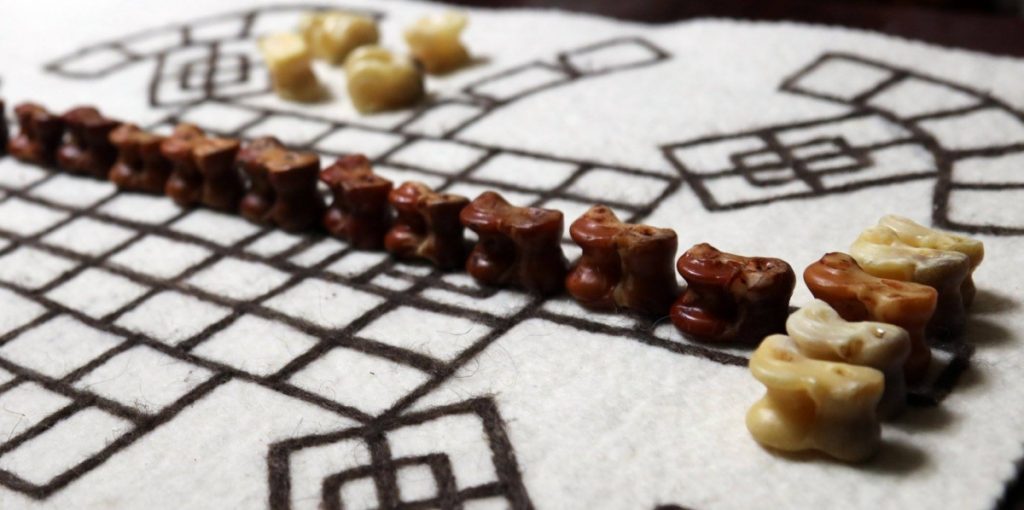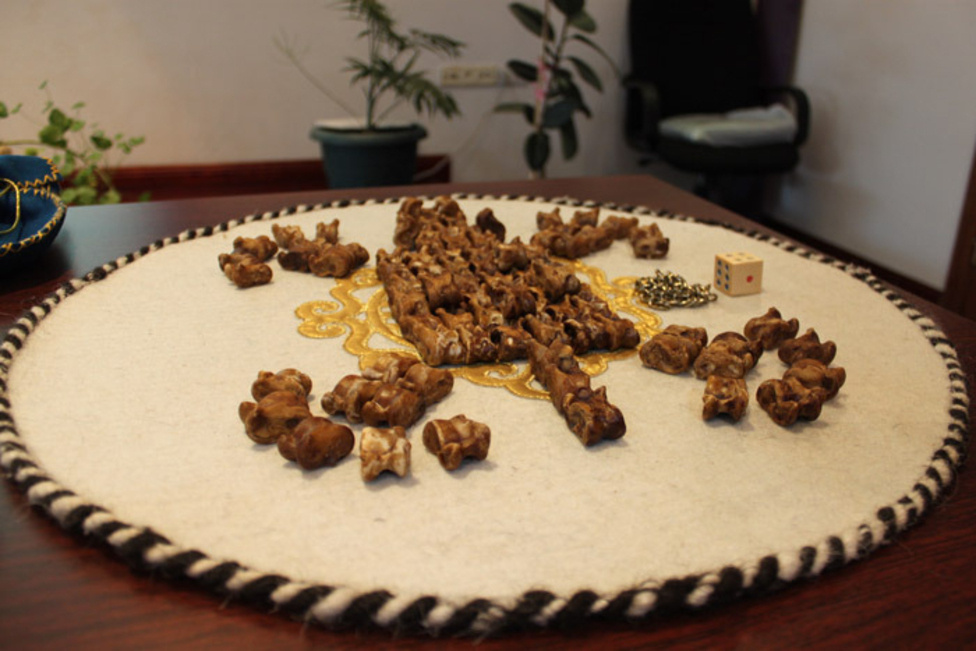Shagain naadgai or the ankle-bone games have been played by Mongolians since the ancient times. In 2011, archaeologists found numerous shagais from a child’s grave among burials from the Xiongnu dynasty.
The shagais were sealed by the Mongolian tribes, including the ancient seal of the Genghis Khan, the Ugedei Khan and the Tolui nation. These findings prove how ancient the shagai game is. There is still a belief among Mongolians that the blessings and spirit of the animal lies in the ankle bones, thus the wolf’s ankle-bone is treasured and kept.
The shagais of a sheep or goat are cleaned thoroughly and painted in bright colors and held dear in a special bag or sack. Passing down from generation to generation, the shagais of a family can easily number in the hundreds. The shagais is considered a symbol of animal’s growth, more numbers mean more animals.
There are popular games such as Four Animals or Mongolian Marbles (бөгцөг няслах), Open Catch (шагай шүүрэх), Number guessing (шагай таалцах), Stacking a vibrant tortoise (алаг мэлхий өрөх), and Horse race (морь уралдуулах).
Open catch is a game in which each player takes a turn to place shagais in one hand and toss them up into the air. The aim of the game is to catch as many as possible with the back of the same hand. The caught pieces are tossed up and caught again.
The caught ones are collected by the player. The one who has collected the most pieces once the pool is empty, wins. Open catch is a competitive and enjoyable game that develops players’ agility, vision, speed, and tact.

The most popular game for people of all ages is called “Four Animals” or “Mongolian Marbles”. The four sides of the shagai are like the sides of a coin, each representing four different animals, namely sheep, goat, horse and camel.
The shagais are spread over the felt rug by dropping down.The player looks to see which shagais have the same face, for example, two ‘horses’, and flicks a shagai towards a matching shagai. If it strikes the target without either shagai touching or striking any other shagai then the player can pick up one of the shagais.
The rules include not touching other shagais when picking up a shagai and not changing your mind and so on which make the game entertaining and competitive. If a rule is broken, it will be next player’s turn or, in some cases, his/her collected shagais will be taken away. This game requires patience in the heat of a moment, sleight of hand, visual orientation and careful calculation.
In a guessing game, players hide shagais in the hand and guess how many shagais are there in total. A player who guesses the right number wins. In order to disturb the opponent’s calculation, and make him angry, a player keeps on saying words, phrases, or poems to the opponent.
When playing not only shagais games, but also puzzle or board games, Mongolians often make up a poem and a wish, say sarcastic things about the opponent and praise the success and skills of each other, cheering and supporting. Parents also use fine words and explain the meaning and rules of the game to expand children’s vocabulary and to develop their cognitive skills. There are many versions dedicated for each game.
Another interesting game is “Stacking a vibrant tortoise”. This game emerged from the Mongolian legend that God shot the giant tortoise floating on the sea and the earth was created.
When the tortoise died, the fire element was created by the fire out of tortoise’s mouth, the water element from behind, the iron element from the pinned up arrowhead, the wooden element from the grasp and the earth element from the body. Moreover, horoscope is also calculated in the nine-grid table which looks like the tortoise’s shell.
The goal of the game is to stack a shape of tortoise which created the world by using shagais. A dice is rolled and the according to the number the shagais, representing the body parts, are taken and the game is played, symbolizing luck and auspiciousness in the future. It is a tradition to play this game during the Lunar new year, introducing children and youth the theory of the five elements of Mongolian horoscope and lunar calendar.

Horse race is the favorite game of children. Each player takes a shagai as his playing piece – a horse. A “track” is made by placing 12 shagai end on end. Each shagai will act as a marker for a “square” of the track. The players’ pieces are lined up alongside the first shagai on the track.
Depending on the number of players, there can be tracks for five different ages of horses like the Naadam horse race. Players then take it in turns throwing fourshagais that are used as “dice”. They can move their horse forward for every “horse” they roll. A “horse” stays in the same place until a horse is rolled by shagais.
A felt rug is spread on the floor for shagai games. When playing this game, the horse race is taken as it is done during the Naadam saying the race is half way through after the first horse finishes the half way and the horse titles are called out loudly when the game is finished.
With half of the population living in the urban areas away from nomadic way of life, traditional games, particularly shagai games, are forgotten. Although many families still collect shagais for children to play with, modern technology is bringing a challenge to the Ancient world of Mongolia to keep these traditional games alive. Thus, many activities have been organized efficiently to promote the game to children and to put the shagai games in the pre-school education curriculum.
Visit: Available Tours
Resource: mongoliatravel.guide

